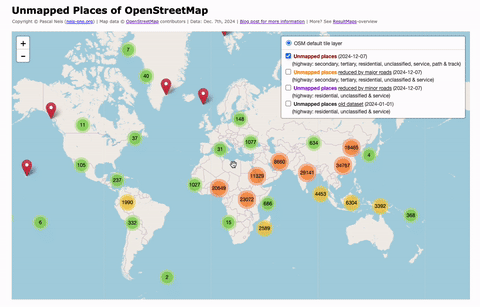Tag: World
-

Unmapped Places of the OpenStreetMap World – 2024
In 2010, I first conducted a study which identified regions (places) in the OpenStreetMap (OSM) project in Germany that still had potential for more detailed mapping. Later, in 2016, this analysis was repeated and extended to the entire world. I have since regularly carried out these studies and published the results. The algorithm and some…
-
#100 – Thank you!
While I was working on my latest blog post, I realized that I had already written 100 posts over the past nine years. All posts have one thing in common: They are about the well-known and maybe never ending OpenStreetMap project …
-
Review requests of OpenStreetMap contributors
– How you can assist! –The latest version of the OpenStreetMap editor iD has a new feature: “Allow user to request feedback when saving”. This idea has been mentioned in a diary post by Joost Schouppe about “Building local mapping communities” (at that time: “#pleasereview”) in 2016. The blog post also contains some…
-
Who is commenting?
An Overview about OSM Changeset DiscussionsAs mentioned in my previous blog post about detecting vandalism in OpenStreetMap (OSM) edits, it’s highly recommended that contributors use public changeset discussions when contacting other mappers regarding their edits. This feature was introduced at the end of 2014 and is used widely by contributors today. Each and every comment is listed publicly and every…
-
Detecting vandalism in OpenStreetMap – A case study
This blog post is a summary of my talk at the FOSSGIS & OpenStreetMap conference 2017 (german slides). I guess some of the content might be feasible for a research article, however, here we go: Vandalism is (still) an omnipresent issue for any kind of open data project. Over the past few years the OpenStreetMap…
-
Reviewing OpenStreetMap contributions 1.0 – Managed by changeset comments and discussions?
The OSM project still records around 650 new contributors each day (out of almost 5,000 registered members per day). Some countries (such as Belgium or Spain) already provide platforms to coordinate the introduction to OSM for new mappers. Others use special scripts …
-
A comparative study between different OpenStreetMap contributor groups – Outline 2016
Over the past few years I have written several blog posts about the (non-) activity of newly registered OpenStreetMap (OSM) members (2015, 2014, 2013). Similarly to the previous posts, the following image shows the gap between the number of registered and the number of active OSM members. Although the project still shows millions of new…
-
Unmapped Places of OpenStreetMap – 2016
Back in 2010 & 2011 I conducted several studies to detect underrepresented regions a.k.a. “unmapped” places in OpenStreetMap (OSM). More than five years later, some people asked if I could rerun the analysis …
-
Verified OpenStreetMap contributor profiles?
The reputation of a contributor in OpenStreetMap (OSM) plays a significant role, especially when considering the quality assessment of the collected data. Sometimes it’s difficult …
-
Good #Hashtags in OpenStreetMap Changesets
#Hashtags are commonly used on Twitter to find content for a specific topic. Also in the OpenStreetMap (OSM) universe they are popular and utilized to mark changesets, which have been contributed during a special event, such as mapping parties or HOT tasks. However, in most cases, they …